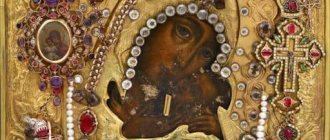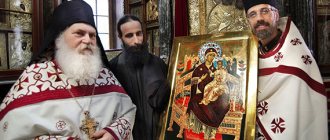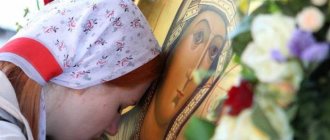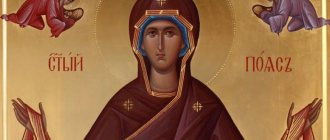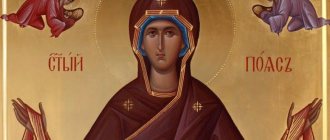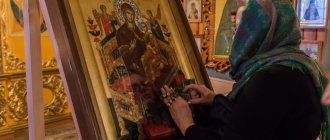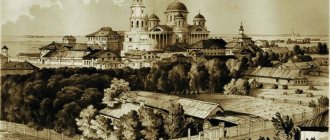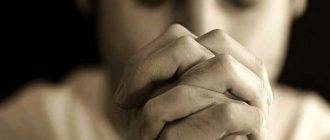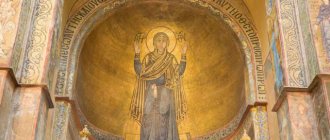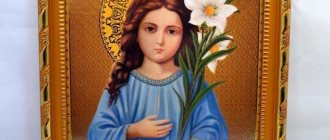The nine-month period of carrying a child in the womb is very responsible and exciting for every expectant mother, because the birth of a new soul into the world is a real miracle performed by the Almighty Father. During pregnancy, women often experience anxiety about the future of the newborn: whether the position of the fetus is correct, whether the due date will arrive on time, and what the birth itself will be like.
If people want to receive help in overcoming this important period, the Church advises praying in front of the appropriate images that patronize pregnant women.
Description and meaning of the “Assistant in Childbirth” icon
There are several known icons depicting the pregnant Mother of God. In one of the rarest paintings, the Most Pure Virgin Mary is presented before her approaching birth with the Child in her womb, whose face is hidden from view. This is how the icon painters of Georgia and Athos represented the Mother of God.
The face of the Mother of God glows with calmness and meekness in anticipation of the birth of the Baby. Both hands are raised up, palms facing the believers, as if warding off evil and danger.
But in Orthodoxy, a more common image is called “Help in Childbirth” (“Assistant in Childbirth”). There are several varieties of this icon:
- “Helper to wives to give birth to children”;
- "Blissful Womb";
- “The word became flesh” (“And the word became flesh”).
The common thing that unites all the lists is that the Most Pure Mother of God is depicted with the Child of God in her womb.
Characteristic features by which you can recognize the image of the “Helper”:
- The Virgin Mary is depicted from the waist up;
- Jesus Christ is located at waist level in a golden frame, which creates the feeling of being inside the Mother;
- the naked God-Infant stands or sits with his hands folded on his chest in a cross;
- The Mother of God is wearing an emerald tunic, over which is draped a scarlet cloak with gold trim;
- the head tilted slightly to the left is covered with a white scarf, indicating holiness;
- the forehead and shoulders are decorated with stars, symbolizing the virginity of the Blessed Virgin Mary;
- The hands of the Mother of God are folded on her chest, over the womb with the Baby, as if protecting him.
Different versions of the image differ in minor details. For example, there are ancient images of the “Helper of Wives”, in which the Mother of God is presented in full growth, and her hands are raised and spread to the sides with palms facing outward.
On another, more ancient icon, the head of the Most Pure Virgin is uncovered, her loose hair falls in waves to her shoulders.
There is another option in which the hands of the Virgin Mary are located under the naked Child. This type of writing is inherent mainly in the icons “And the Word became Flesh.”
The icon belongs to the iconographic type of the Sign. The meaning of the icon for Orthodox believers is indicated by the name itself, reflecting the theological meaning of the image. The Most Pure Virgin Mary carried the Son of God in her womb, just as in the Old Testament Moses carried the ark with the stone tablets. After the people stopped keeping God's commandments, an angry Moses sent the ark on two oxen into the desert, where all traces of it disappeared.
By the time the Savior came to earth, the Infant God was placed in the womb of the immaculate Virgin Mary by the Holy Spirit. From that time on, the Mother of God began to carry the “ark of the new Testament.”
Jesus Christ, depicted in the holy image, is a symbol of the Sacred Word, materialized in the womb of the Queen of Heaven and becoming flesh.
History of the appearance of the image
The first mention of the “Blessed Womb” icon, which helps during childbirth, dates back to the 14th century. The name of the icon painter is unknown. The image was discovered in the Italian city of Bari on the tomb with the relics of St. Nicholas, so it was nicknamed Barbara.
Later, the icon was transported to Moscow along with the remains of St. Nicholas the Wonderworker, placing it in the Kremlin Annunciation Church. The veneration of the icon falls on January 8th.
There is also the Albazin holy image “The Word became flesh,” known since the 17th century. The shrine came to the Amur fortress of Albazia thanks to Hieromonk Hermogenes. During the Chinese raids on the Amur lands, the holy image was transported to Sretensk. At the request of Bishop Veniamin of Kamchatka, a silver frame was built for the icon for use of the image during the religious procession.
According to legend, thanks to the shrine, the Chinese attack on Blagoveshchensk in the 20th century was repulsed and the raging plague epidemic was stopped. The celebration of the icon takes place on March 22.
Where is the icon of the pregnant Virgin Mary located?
In order to see the Georgian icon of the pregnant Virgin Mary, you will have to go to the Greek city of Raches, where it is kept in the small church of St. Raphael.
The fate of the original Orthodox icon “Helper in Childbirth,” located in Blagoveshchensk since 1924, is unknown. But several lists made from this image have survived.
One of the copies, the writing of which dates back to the 17th century, was for some time in the Novodevichy Convent. In 1927, the holy image was transferred to the Moscow Armory Chamber for storage. One of the lists, written by icon painter Ioann Aksentyev, was transferred for storage to the Khabarovsk Museum of Local Lore during Soviet times, where it was kept until 1999. Since 2002, the holy face can be seen in the Khabarovsk Church of the Dormition of the Mother of God.
There are several more Russian churches where lists of the miraculous icon are located:
- Serpukhov Cathedral of St. Nicholas Bely;
- Yekaterinburg Church of the Nativity;
- St. Petersburg Holy Trinity Izmailovsky Cathedral;
- Moscow St. Alexeevsky Convent;
- Borovsky Church of the Kaluga region in the name of the holy princes Gleb and Boris;
- Church of All Saints, located in Krasnoe Selo.
All lists have the same healing power as the original image.
Important: when your request is not heard
There are cases when a person is not destined to have his own child. For example, he came into this world in order to reveal himself in serving people, in work, science, etc. If this is about you, prayers will not give any result.
It could be much worse - the Higher Powers will send a sick child. Why is this happening? It is not a person’s destiny to have offspring, but he is trying to “bend the situation” to suit himself. The child will be sent. But it will not be a blessing, but an additional life cross for you. Therefore, at the end of any prayers, it is highly advisable to add: “If it be Your will, Lord.”
How does the icon of the pregnant Mother of God help?
The sacred image with the face of the pregnant Mother of God became famous for its miraculous power. Not every woman has an easy pregnancy. Various complications often arise.
Therefore, the image of the pregnant Mother of God is turned to when various pathologies arise:
- threat of premature termination of pregnancy;
- the development of a disease in a woman that threatens the life and health of the mother and child;
- incorrect presentation of the fetus;
- severe toxicosis, complicating the course of pregnancy;
- detection of abnormalities in fetal development.
But prayers to the Mother of God help not only during complications accompanying pregnancy. Those who have difficulties conceiving a child also turn to the holy image. Prayer before the holy face works miracles and gives the joy of motherhood even to women whom doctors have given a disappointing diagnosis.
The image of the pregnant Virgin Mary provides moral support to expectant mothers, helping to overcome psychological difficulties, fear of the upcoming birth, and depression.
But this does not mean that it is enough to pray to the Mother of God a couple of times and all problems will be resolved. A pregnant woman should take care not only of her body and physical condition, but also of her soul. It is extremely important for the expectant mother to lead a pious, righteous life.
If a woman often gets irritated, angry, envy, anger or despondency during pregnancy, this has a negative impact on the fetus. Prayers to the “Helper in Childbirth” icon help to overcome harmful emotions. Our Lady gives peace and tranquility.
Visiting the temple is important, especially before childbirth. But if the pregnancy is difficult, a woman can pray at home by purchasing an icon with the image of the pregnant Mother of God. The clergy also recommend taking communion and confession before giving birth.
How to ask correctly
In the houses of Old Slavonic wealthy families and simple peasants there was an icon “Receiver at Childbirth”. In front of the icon, people fervently prayed for the life of the woman in labor. The icon was placed so that the woman could see it from her bed. Their sufferings and prayers were addressed to the patron saint.
The icon was considered an attribute of midwives.
Before giving birth
In the modern Orthodox tradition, for a successful birth, confession and Holy Communion must be received at the beginning of pregnancy. If it is not possible to visit church, or there is no trusted confessor, it is important to remember your sins before the icon and repent for them without excuses, but with humility.
There are no clear rules for praying in front of the “Helper in Childbirth” icon. The most important thing in prayer is sincerity and consistency.
Recommendations for prayer for pregnant women:
- Contact the Mother of God at any free moment when your soul asks for it;
- Do not say this prayer forcibly, without understanding the meaning of the words, if you feel unwell or are under pressure from loved ones;
- Voluntary private prayer can help relieve anxiety;
- Pay attention to your state of mind, control your anger and irritation. If you feel negative emotions approaching, pray to Our Lady and retire;
- If anger caused by a hormonal disorder was poured out on a family member, you should ask for forgiveness from the Virgin Mary and the offended person;
- At the beginning of prayer work, you should make it a rule that prayer is read in the morning and in the evening. When the words are memorized after frequent repetition, you can repeat them to yourself throughout the day;
- The text of the prayer is easy to carry and read if it is printed on a small sheet of paper in small print;
- One must approach the icon with repentance, with a request to pray to the Lord for a miracle for the unworthy. For there is no sinless person on earth;
- Before reading the canonical text or delivering a speech in your own words, read the Lord's Prayer three times and then the troparion of praise;
- The troparion can be used to begin or end a prayer;
- it does not matter which canonical text is read. Choose the prayer option that resonates with your soul and matches your circumstances or fears;
- Alternating prayers will help you understand which one is closer;
- It is important to treat the image with respect and approach it in neat clothing;
- Prayer can be personal or with your husband.
Relatives and friends can pray for the woman in labor and the child in front of the “Helper in Childbirth” icon. Small icons and pendants are sold in church shops. The worn icon can be worn on a chain around the neck, while in the hospital and a prayer can be read over it before childbirth. In some hospitals that cooperate with churches, the icon of the “Helper at Birth” is placed in the corner of the delivery room.
After birth
After the birth of a child, you should order a thanksgiving prayer service, akathist or prayer at home in church to thank the Lord for His mercy. Immediately after giving birth, a woman is not allowed to enter the church. She is given time to cleanse herself. This period lasts until the child is baptized. The natural mother cannot participate in this sacrament, so a godmother is appointed. After baptism, the priest blesses the mother to enter the church and reads a prayer of purification over her.
Prayer text
Before the icon of the Mother of God awaiting the birth of the Child, the following prayer is read:
“O Most Holy Lady Lady Theotokos, who never leaves us in earthly life! To whom will I offer prayers, to whom will I bring tears and sighs, if not to You, Comfort to all the faithful! With fear, faith, love, Mother of the Belly, I pray: May the Lord enlighten Orthodox people to salvation, may He allow us to give birth to children for You and Your Son to please You, may He keep us in the purity of humility, in the hope of salvation in Christ, and grant us all, in the veils of Thy grace, earthly consolation. Keep us under the canopy of Thy mercy, Most Pure One, help those who pray for childbirth, turn away the slander of evil freedom, grave troubles, misfortunes and deaths. Grant us grace-filled insight, a spirit of contrition for sins, grant us to see all the height and purity of Christ’s teaching given to us; protect us from disastrous alienation. May we all, who gratefully praise Thy greatness, be worthy of Heavenly tranquility and there with Thy beloved, with all the saints, let us glorify the One God in the Trinity: the Father and the Son and the Holy Spirit, now and ever, and unto the ages of ages. Amen".
How to prepare for the birth of a baby
Spiritual preparation for pregnant women includes:
- visiting a temple;
- confession;
- participle;
- prayer;
- participle.
Before giving birth, a woman must cleanse her soul in confession so that the child does not grow up under the weight of her sins. Prayer, communion and confession will fill the soul with peace and joy. Staying in grace and humility, it will be easier to endure unpleasant physiological changes in the body: toxicosis, varicose veins, excess weight, mood swings. A conversation with a confessor can help overcome fears and irritability.
During pregnancy and before giving birth, a woman can experience a friendly and joyful atmosphere in the church. Church communities hold special meetings. At these special meetings, young women about to give birth to their first child can ask their priest questions, and mothers of many children can share their experiences of overcoming heartache, anxiety, depression and other problems. Saying prayers, the expectant mother strengthens her spirit, distances herself from the hustle and bustle and immerses herself in the blissful anticipation of the child. She will feel spiritual unity and support before giving birth during general family prayer with her husband, parents and friends.
In a church community, consensual prayer can be organized with other women. Prayer at a set time unites everyone in common hope, joy and love. When the baby feels wanted and loved, the birth will go smoothly.
Since ancient Slavic times, women were advised to control their anger and pride during periods of imprisonment. The obstetricians knew that the anger and resentment would be passed on to the baby. Buried grudges are considered especially destructive. For this reason, forgiveness is an important step in spiritual preparation before childbirth. It is necessary to reconcile with those who have offended, or to reconcile if reconciliation is impossible. Often, even the bright joy that accompanies the birth of a child is not enough for relatives to begin to get closer to each other. In anticipation of birth, it is necessary to abandon hostility and avoid negativity. The expectant mother needs to be cared for by experience, like the protection of Joseph's groom.
